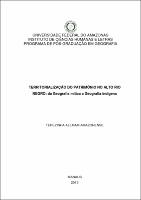| ???jsp.display-item.social.title??? |


|
Please use this identifier to cite or link to this item:
https://tede.ufam.edu.br/handle/tede/2789Full metadata record
| DC Field | Value | Language |
|---|---|---|
| dc.creator | Amazonense, Terezinha Alemam | - |
| dc.creator.Lattes | http://lattes.cnpq.br/2143417465618141 | por |
| dc.contributor.advisor1 | Faria, Ivani Ferreira de | - |
| dc.contributor.advisor1Lattes | http://lattes.cnpq.br/9910677483036522 | por |
| dc.date.available | 2015-04-09 | - |
| dc.date.issued | 2013-09-02 | - |
| dc.identifier.citation | AMAZONENSE, Terezinha Alemam. Territorialização do patrimônio no Alto Rio Negro: da geografia mítica a geografia indígena. 2013. 145 f. Dissertação (Mestrado em Geografia) - Universidade Federal do Amazonas, Manaus, 2013. | por |
| dc.identifier.uri | http://tede.ufam.edu.br/handle/tede/2789 | - |
| dc.description.resumo | O presente trabalho apresenta a percepção dos povos indígenas do Alto Rio Negro sobre cultura, patrimônio e território, identificando e descrevendo os mesmos de modo a buscar nas leis e políticas culturais, nacionais e internacionais, subsídios que forneçam instrumentos necessários para revitalização e fortalecimento destes patrimônios territorializados que são vistos como indissociáveis entre homem/natureza, destacando a Geografia indígena. Os estudos buscaram diagnosticar os impactos socioambientais decorrentes das formas de uso destes patrimônios. Para isto, pelo procedimento metodológico fez-se a revisão bibliográfica sobre trabalhos produzidos por pesquisadores sobre o Alto Rio Negro; foram realizadas sessenta entrevistas com idosos, adultos e jovens indígenas falantes das três línguas co-oficializadas no município de São Gabriel da Cachoeira em 2002: Baniwa, Nhengatú e Tukano; a observação direta enfocou os impactos socioambientais sobre o patrimônio. Os resultados indicam que: a cultura, o patrimônio e o território na concepção indígena estão intimamente conectados e determinam os modos de vida, os valores dispostos por todo o território; o registro do patrimônio por si só não fortalece a identidade, esta deve ser difundida e praticada através da educação ambiental/patrimonial nas escolas e comunidades. As conclusões que faz é que as leis existentes encontram-se sempre em fase de implantação e experiências, mas não correspondem à realidade. Por isso tem-se como proposição ouvir e ver o futuro preconizado por estes povos que legitimam a posse do território referenciados em suas memórias herdados de seus antepassados e deixem de ser objetos de estudo e tornem-se sujeitos do próprio conhecimento. | por |
| dc.description.abstract | This paper presents the realization of indigenous peoples of the Upper Rio Negro on culture , heritage and territory , identifying and describing them in order to get the laws and policies of cultural, national and international grants that provide the necessary tools for revitalization and strengthening of these assets territorialized that are seen as inseparable from man / nature, highlighting the indigenous Geography. The studies sought to diagnose the environmental impacts arising from the use of these types of assets. For this, the methodological procedure became a literature review on works produced by researchers on the Upper Rio Negro ; sixty interviews were conducted with elderly adults and young indigenous speakers of the three languages co - made official in the municipality of São Gabriel da Cachoeira in 2002: Baniwa Nhengatu and Tukanoans; direct observation focused on the social and environmental impacts on equity. The results indicate that: the culture , heritage and indigenous territory in the design are closely connected and determine ways of life, values arranged throughout the territory; registration of equity alone does not strengthen the identity, it must be widespread and practiced through environmental education / equity in schools and communities. The conclusions it does is that existing laws are always under implementation and experiences , but do not correspond to reality. Therefore it is thought proposition hear and see the future envisaged by these legitimizing possession of the territory referred in his memoirs inherited from their ancestors and no longer objects of study and become subjects of knowledge itself . | eng |
| dc.description.sponsorship | Fundação de Amparo à Pesquisa do Estado do Amazonas | - |
| dc.format | application/pdf | por |
| dc.thumbnail.url | http://200.129.163.131:8080//retrieve/8437/Terezinha%20Alemam%20Amazonense.pdf.jpg | * |
| dc.language | por | por |
| dc.publisher | Universidade Federal do Amazonas | por |
| dc.publisher.department | Instituto de Ciências Humanas e Letras | por |
| dc.publisher.country | BR | por |
| dc.publisher.initials | UFAM | por |
| dc.publisher.program | Programa de Pós-graduação em Geografia | por |
| dc.rights | Acesso Aberto | por |
| dc.subject | Patrimônio | por |
| dc.subject | Território | por |
| dc.subject | Cultura | por |
| dc.subject | Povos Indígenas | por |
| dc.subject | Geografia Indígena | por |
| dc.subject | Heritage | eng |
| dc.subject | Territory | eng |
| dc.subject | Culture | eng |
| dc.subject | Indigenous Peoples | eng |
| dc.subject | Indigenous Geography | eng |
| dc.subject.cnpq | CIÊNCIAS HUMANAS: GEOGRAFIA | por |
| dc.title | Territorialização do patrimônio no Alto Rio Negro: da geografia mítica a geografia indígena | por |
| dc.type | Dissertação | por |
| Appears in Collections: | Mestrado em Geografia | |
Files in This Item:
| File | Description | Size | Format | |
|---|---|---|---|---|
| Terezinha Alemam Amazonense.pdf | 6.27 MB | Adobe PDF |  Download/Open Preview |
Items in DSpace are protected by copyright, with all rights reserved, unless otherwise indicated.




